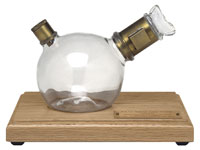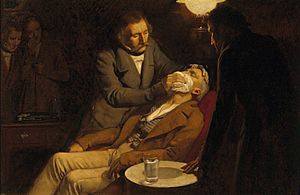William T. G. Morton facts for kids
Quick facts for kids
William Thomas Green Morton
|
|
|---|---|
 |
|
| Born | August 9, 1819 |
| Died | July 15, 1868 (aged 48) |
| Nationality | American |
| Known for | First use of Ether in surgical operations |
| Spouse(s) | Elizabeth Whiteman |
| Scientific career | |
| Fields | Dentistry |
| Influences | Charles T. Jackson Horace Wells |
William Thomas Green Morton (born August 9, 1819 – died July 15, 1868) was an American dentist and doctor. He is famous for being the first person to publicly show how to use ether to make surgery painless in 1846. This was a huge step forward in medicine. For the rest of his life, he worked hard to prove he was the true discoverer of this amazing new way to stop pain during operations.
Contents
Early Life and Learning
William T. G. Morton was born in Charlton, Massachusetts. His father, James Morton, was a miner. William worked as a clerk, printer, and salesman in Boston. In 1840, he started studying at the Baltimore College of Dental Surgery.
In 1841, he became known for a new way to attach false teeth to gold plates. He left college in 1842 and studied with another dentist, Horace Wells, in Hartford. They even worked together for a short time.
In 1843, Morton married Elizabeth Whitman. Her parents did not like his job as a dentist. They only agreed to the marriage after he promised to study medicine. So, in 1844, Morton went to Harvard Medical School. There, he learned about the pain-relieving effects of ether from his chemistry teacher, Charles T. Jackson. Morton left Harvard without finishing his degree.
A Big Step for Medicine
On September 30, 1846, Morton used ether to pull a patient's tooth without pain. A newspaper wrote about this success. A famous surgeon named Henry Jacob Bigelow then set up a public demonstration.
This important event happened on October 16, 1846. It took place at the Massachusetts General Hospital (MGH) in their operating room. During this demonstration, Dr. John Collins Warren painlessly removed a tumor from a patient's neck.
News of this amazing use of ether quickly spread around the world. The first time ether was used outside the USA was in London, England. A dentist named James Robinson used it for a tooth extraction. The operating room at MGH where this happened is now called the Ether Dome. It is kept as a monument to this historic day.
After the demonstration, Morton tried to keep the substance a secret. He called it "Letheon." But soon, everyone found out it was ether.
The Patent Controversy
About a month after the demonstration, Morton received a patent for "letheon." However, doctors and scientists did not like this. They felt it was wrong to patent something so important for helping people.
Morton told his colleagues he would not stop hospitals from using ether. He said he wanted the patent to make sure ether was used correctly. He also wanted to get back the money he spent developing it. But Morton's actions to get patents in other countries made people doubt his good intentions. Because of this, the patent was not really enforced, and ether soon became widely used.
In December 1846, Morton asked the U.S. Congress for $100,000. He wanted this money as a reward for his discovery. But other doctors, like Jackson and Wells, also claimed to have discovered ether. This made Morton's request difficult, and it failed. He tried again several times, but his requests were never approved. He even tried to sue the U.S. government later, but that also failed.
In 1852, he received an honorary degree from Washington University of Medicine in Baltimore.
In 1857, a rich man from Boston, Amos Lawrence, and other important people tried to raise money for Morton. They wanted to give him $100,000 as a national thank you. People from the public and private citizens gave money.
Morton became even more well-known when he was a witness in a famous trial. This was the trial of John White Webster, who was accused of murder. Morton's rival, Dr. Jackson, spoke for the other side. People in Boston were excited to see these two rivals face each other in court.
Morton also helped his country during the Civil War. In 1862, he joined the Army of the Potomac as a volunteer surgeon. He used ether to help over two thousand wounded soldiers. He worked during battles like Fredericksburg, Chancellorsville, and the Wilderness.
Later Life and Passing
In July 1868, Morton was in New York City. He was riding in a carriage with his wife. Suddenly, he asked the carriage to stop and ran into a lake in Central Park. He wanted to "cool off." This strange behavior was because he had a major stroke. He died soon after.
Morton was taken to a nearby hospital, St. Luke's. His wife showed three medals, saying they were all he had ever received for his important work.
He is buried at Mount Auburn Cemetery in Watertown and Cambridge, Massachusetts.
His Lasting Impact
In 1871, a group of people who had tried to raise money for Morton published a book. It was called The Historical Memoranda Relative to the Discovery of Etherization. This book aimed to show that Morton was the true inventor of using ether to stop pain. It also argued that his family should be rewarded for his discovery.
Morton's life and work were later made into a movie in 1944. It was called The Great Moment. The movie was based on a book from 1940 called Triumph Over Pain.
The first use of ether to stop pain is remembered by the Ether Monument in the Boston Public Garden. The people who designed the statue did not want to pick a side in the debate over who deserved credit. So, the statue shows a doctor in old-fashioned robes.
Morton's first successful public demonstration of ether was a very important event. Many people see him as the "inventor" of anesthesia. However, another surgeon named Crawford Williamson Long had used ether as early as March 30, 1842. Long showed its use to doctors in Georgia many times. But he did not publish his findings until 1849.
These early uses of ether were key to developing modern surgery. They also led to the medical field we now call anesthesiology. The news of this "new" way to stop pain spread quickly. This was partly because of the arguments that happened between Morton, Horace Wells, and Charles T. Jackson.
Morton's son, William J. Morton, also became a well-known doctor. He was an expert in using electricity for medical treatments.
See also
 In Spanish: William Morton para niños
In Spanish: William Morton para niños





